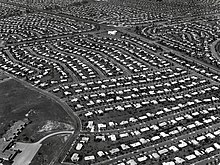Levittown
This article needs additional citations for verification. (December 2021) |

Levittown is the name of several large suburban housing developments created in the United States (including one in Puerto Rico) by William J. Levitt and his company Levitt & Sons. Built after World War II for returning white veterans and their new families, the communities offered attractive alternatives to cramped central city locations and apartments. The Veterans Administration and the Federal Housing Administration (FHA) guaranteed builders that qualified veterans could buy housing for a fraction of rental costs.
The first Levittown home sold for $7,900 and in a short period of time, 17,000 units were sold, providing homes for 84,000 people. In addition to normal family dwellings, Levittowns provided private meeting areas, swimming pools, public parks, and recreational facilities.[1]
Production was modeled on assembly lines in 27 steps with construction workers trained to perform one step. A house could be built in one day, with 36 men, when effectively scheduled.[2][3] This enabled quick and economical production of similar or identical homes with rapid recovery of costs. Standard Levittown houses included a white picket fence, green lawns, and modern appliances. Sales in the original Levittown began in March 1947. 1,400 homes were purchased during the first three hours.
The homes were, by later standards, bare bones: 750 sq ft (70 m2), with no basement or porch.[4]
Places
- Levittown, New York – the first Levittown (built 1947–1951)
- Levittown, Pennsylvania – the second Levittown (1952–1958)
- Willingboro Township, New Jersey – originally and colloquially known as Levittown (started 1958)
- Levittown, Puerto Rico (1963)
- Bowie, Maryland (1964)
Gallery
Controversy
William J. Levitt refused to sell Levittown homes to non-Caucasians. The FHA, upon authorizing loans for the construction of Levittown, included racial covenants in each deed, making each Levittown a segregated community.[5]
The first black family, the Myers, who bought a second-hand house there in Pennsylvania, in 1957 experienced attacks on their house, and up to 500 people gathering outside their house. Martin Luther King met with the family, and their plight led to legislative change. They stayed for four years until William Myers, a World War II veteran, got a job elsewhere.[6]
See also
References
- ^ Handbook to life in America. Volume VIII, Postwar America, 1950 to 1969. Rodney P. Carlisle. New York, NY: Facts on File. 2009. ISBN 978-1-4381-2699-9. OCLC 466379549.
{{cite book}}: CS1 maint: others (link) - ^ "A City is Born - Levittown, PA". ProQuest Alexander Street. 1953. Retrieved 2022-02-19.
The building of a house in one day is shown during the next 45 seconds by stop-motion photography. These are the 36 men who built this house. Another day, another 40 houses. This is one of four models, which are now being built throughout Levittown. The complete price is $10,500.
- ^ "The Fifties". Annenberg Learner. Retrieved 2022-02-19.
- ^ Rybczynski, Witold (February 1991). "Living Smaller". The Atlantic. Retrieved December 22, 2023.
- ^ Rothstein, Richard (May 2, 2017). The Color of Law: A Forgotten History of How Our Government Segregated America. Liveright. pp. 82-83. ISBN 978-1-63149-286-0.
- ^ "Trailblazers: The Story of the Myers Family in Levittown, Pennsylvania". The Daily Beast. 25 July 2019.



